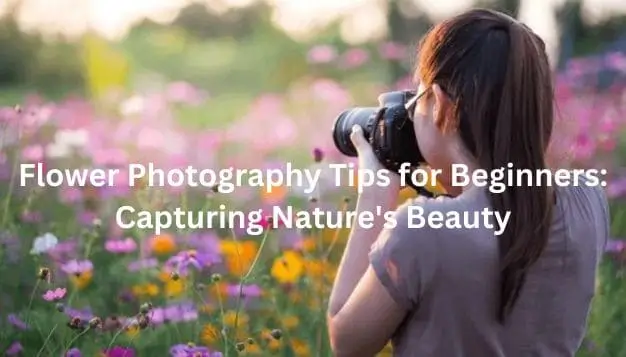Flower photography is a delightful and rewarding pursuit for both amateur and professional photographers. The vibrant colors, intricate details, and the inherent beauty of flowers make them perfect subjects for capturing stunning images.
Taking beautiful photos of flowers can be a very rewarding hobby or even a career. With the right techniques and equipment, anyone can capture stunning images of flowers.
If you’re a beginner looking to explore the art of flower photography, this guide will provide you with valuable tips to enhance your skills and create captivating floral images.
Here are some key tips for beginners looking to get started with flower photography:
Choose the Right Flowers
Not all flowers make good photographic subjects. Ideally you’ll want to photograph flowers that are vibrantly colored, visually striking, and freshly bloomed. Some examples of flowers that photograph beautifully include roses, tulips, lilies, orchids, sunflowers, peonies, and carnations. Avoid flowers that are wilted, past peak bloom, or have non-distinct colors and shapes.
Choose the Right Time and Lighting
One of the most critical aspects of flower photography is lighting. Optimal lighting can make a significant difference in the outcome of your photos. The best time to photograph flowers is during the golden hours, shortly after sunrise or before sunset, when the light is soft and warm. Overcast days can also provide diffused light, reducing harsh shadows and enhancing the colors of the flowers.
Select a Suitable Background
The background of your flower photos can greatly impact the overall composition. Look for clean and uncluttered backgrounds that complement the colors and shapes of the flowers. Consider using a wide aperture (low f-stop) to create a shallow depth of field, blurring the background and making the flowers stand out.
Understand Your Camera Settings
Familiarize yourself with your camera’s settings, especially aperture, shutter speed, and ISO. For flower photography, using a wide aperture (e.g., f/2.8 to f/5.6) can create a beautiful bokeh effect, isolating the flower from the background. Adjust your shutter speed to freeze motion or capture intentional motion blur, and keep the ISO as low as possible to maintain image quality.
Use a Tripod for Stability
Achieving sharp and detailed flower photos often requires a steady hand. A tripod can be immensely helpful, especially when shooting in low light conditions or using slow shutter speeds. It allows you to frame your shot precisely and eliminates the risk of camera shake, resulting in clearer and more professional-looking images.
Experiment with Composition Techniques
Explore various composition techniques to add visual interest to your flower photographs. The rule of thirds, leading lines, and framing can enhance the overall composition. Experiment with different angles, such as shooting from above, eye level, or below the flowers, to discover unique perspectives that showcase their beauty in a fresh way.
Pay Attention to Depth of Field
Controlling the depth of field is crucial in flower photography. Experiment with different aperture settings to achieve the desired level of sharpness. A shallow depth of field can isolate the flower from the background, while a deeper depth of field can capture more details in the entire scene. Understand the impact of your chosen aperture on the final image.
Focus on Details and Textures
Flowers are intricate and detailed subjects, and capturing their details can result in stunning photographs. Use a macro lens or the macro mode on your camera to get up close and highlight the intricate patterns, textures, and colors of the petals. Pay attention to the play of light on the surfaces to add depth and dimension to your images.
Be Mindful of the Wind
Wind can be a challenge when photographing flowers, as it may cause motion blur or make it difficult to focus. Consider shooting on calmer days or early in the morning when the wind is usually gentler. If wind is unavoidable, increase your shutter speed to freeze the motion, or use a higher ISO to maintain a faster shutter speed.
Post-Processing for Enhancement
After capturing your flower photos, consider post-processing to enhance colors, contrast, and sharpness. Software like Adobe Lightroom or Photoshop can help you fine-tune your images. However, always aim to preserve the natural beauty of the flowers and avoid over-editing, which can result in unrealistic or unnatural-looking photographs.
Patience is Virtue
Photographing flowers requires time and patience. Move slowly and gently around flowers to find just the right lighting and angle. Wait for a breeze to still and flower to turn into perfect position. Take lots of shots varying settings and perspectives until you capture that one amazing image. Great flower photography rewards those with immense patience and persistence.
Mastering flower photography requires practice and persistence, but these tips will help fast track you to creating stunning floral images. Always remember to train your eye to spot beautiful botanicals worthy of photographing. Flex your creative chops to capture floral beauty in new exciting ways. With dedication to continuous learning and improvement, your floral photography abilities will blossom!
Conclusion
Flower photography is a delightful journey that allows you to connect with nature and express your creativity through captivating images. By understanding the fundamental techniques, experimenting with composition, and embracing the unique qualities of each flower, you can create stunning photographs that showcase the beauty of the natural world. Remember, practice and observation are key, so grab your camera, explore the outdoors, and let the beauty of flowers inspire your photographic journey.

